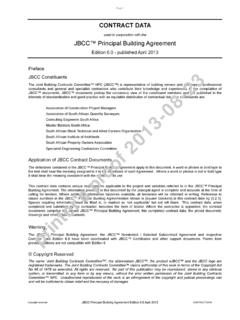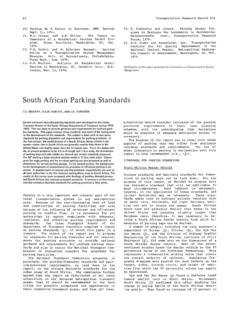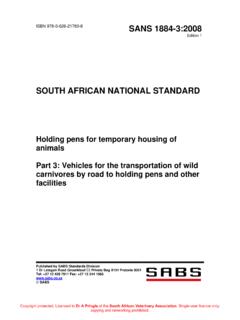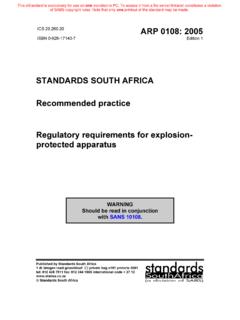Transcription of The application of the National Building - An …
1 This document may not be resold. SABS 0400 1990 UDC ISBN 0-626 08699-X Please note that SANS 10400:1990 (Parts A, C, D, F, G, J, K, M, N, 0, P, Q, S, T, V and W) have been superseded by edition of SANS 10400-A:2010, SANS 10400-C:2010, SANS 10400-0:2011, SANS 10400-F:2010, SANS 10400-G:2011, SANS 10400-J:2010, SANS 10400-K:2010, SANS 10400-M:2011, SANS 10400-N:2010, SANS 10400-0:2011, SANS 10400-P:2010, SANS 10400-0:2011, SANS 10400-S:2011, SANS 10400-T:2011, SANS 10400-V:2010, and SANS 10400-W:2011 respectively. All other parts in this publication are still current. For more information, contact or Code of Practice for The application of the National Building Regulations First Revision Gr 22 Published by THE COUNCIL OF THE south african BUREAU OF STANDARDS The attention of all users of SANS 10400: 1990 is drawn to the special note that appears on the inside cover page, as well as to the amendment to the National Building Regulations and Building Standards Act, 1977 (Act 103 of 1977), Notice No.
2 R. 574, as published in Government Gazette No. 31084 of 30 May 2008, which has been inserted after p. 10 of the standard. This document may not be resold. To users of SANS 10400 (SABS 0400) The application of the National Building regulations (NRB) The National Building Regulations were amended in October 2008, effectively making some of the deemed-to-satisfy provisions of the SANS 10400 incorrect. As the National Technical Committee is still busy with the revision of the SANS 10400, to align its application with the amended regulations, users are hereby warned that compliance with the current SANS 10400 may not be deemed to be satisfying the NBR. The south african Bureau of Standards hereby encourages the users of SANS 10400 to familiarize themselves with the amended National Building Regulations (attached for ease of reference), and to follow other means of satisfying the NBR, submission of a rational design, where ever the SANS 10400 falls short.
3 It is envisaged that the amended SANS 10400 will be published before the end of December 2009, and until such time, the draft standard is available to members of the public from our sales office. WARNING: THE DRAFT MAY CHANGE AT ANY TIME BEFORE PUBLICATION. For any clarity, please feel free to contact us. SABS Standards management Information Services Telephone: 012-428 6666 Fax: 012-428 6928 E-mail: Standards Sales Telephone: 012-428 6883 Fax: 012- 428 6928 E-mail: This document may not be resold. UDC SABS 0400-1990 south african BUREAU OF STANDARDS CODE OF PRACTICE for THE application OF THE National Building REGULATIONS Obtainable from the SA BUREAU OF STANDARDS Private Bag X191 Pretoria Republic of south Africa 0001 Telegrams: Comparator, Pretoria Telex Fax : 321308SA : 3441568 COPYRIGHT RESERVED Printed in the Republic of south Africa by the south african Bureau of Standards This document may not be resold.
4 SABS 0400 1990 2 ACKNOWLEDGEMENT The south african Bureau of Standards wishes to acknowledge the valuable assistance of the National Building Regulations Technical Advisory Committee. NOTICE This code of practice was approved by the Council of the south african Bureau of Standards on 23 August 1990. In terms of regulations promulgated under the Standards Act, 1982 (Act 30 of 1982), it is a punish able offence for any person to falsely claim compliance with the provisions of a code of prac tice published by the south african Bureau of Standards. Authorities who wish to incorporate this code of practice into legislation in the manner intend ed by section 33 of the Act should consult the south african Bureau of Standards regarding the implications concerned. The code includes provisions intended for information and guidance only. These provisions may not be suitable for direct incprporation.
5 This code of practice will be revised and republished in September 1995 in order to keep abreast of progress. Comment received before March 1994 will be considered when the code is revised. The National Building Regulations contained in this code have been reproduced under Govern- ment Printers Copyright Authority No. 8743 of 8 September 1987. [ ISBN 0 626 08699-X First Revision August 1990 This code of practice supersedes SABS 0400-1987 This document may not be resold. 3 SABS 0400-1990 PREFACE Development in the Building industry is a continuous process. With passage of time new materials become available, design methods are refined and innovative Building systems are introduced. It is therefore obvious that Building regulations cannot remain static if they are to allow for the early use of these developments and the eventual acceptance of satisfactory systems as conventional Building methods.]
6 The National Building Regulations differ considerably in appearance antl content from previ ous Building bylaws but this does not mean that the buildings constructed In accordance with these regulations need differ to any great extent from those built in the recent past. It is true that the regulations have been written in their present form in order to encourage the use of innovative design, new materials and new construction methods where these can be shown to be suitable. However, it is equally true that any Building designed in accordance with ac- cepted methods and constructed of conventional materials in accordance with the principles of good Building practice should, in general, comply with the new regulations. The National Building Regulations do not purport, and were never intended, to be a handbook on good Building practice. They set out, in the simplest and shortest way possible, require- ments to ensure that buildings will be designed and built in such a way that persons may live and work in a healthy and safe environment.
7 There are other aspects to a Building which may affect only the comfort or convenience of people but many of these, such as acoustic or ther- mal performance, are judged in a subjective way and are not readily amenable to control in a sensible manner by is also obvious that the market will limit the degree to which these matters can be considered in the design of a Building . It is important, therefore, that entrepreneurs, designers and Building owners shoud ing complies with the National Building Regulations will not automatically indicate that it is a desirable Building . There are many aspects to be considered and the relative economic worth of each must be related to the final cost of the Building . Professional designers are trained to take these mat- ters into account and can be expected to do so without any obstructive and possibly useless control by regulation. In the case where the designer of a Building is not professionally quali fied, there is a wealth of information on good Building practice available in textbooks and from organizations such as the CSIR and the south african Bureau of Standards.
8 As a guide to the understanding and correct interpretation of the National Building Regula- tions it is important to know the thoughts, philosophy and intent behind the regulations. Because these regulations were originally introduced as a long-term anti-inflationary measure it is obvious that they should not increase the overall cost of Building . Another aim was to reduce the number of regulations to a minimum. It was therefore decided that as far as possi- ble, regulations be concerned only with the health and safety of persons in a Building , that all technical aspects be covered by functional regulations and that the regulations be written in such a way that they would assist rather than impede the use of innovative Building sys- tems and designs. This should be kept in mind by any local authority when assessing a build ing in terms of the functional regulations. In applying the National Building Regulations it will be found that in certain instances there is an overlap with the requirements of regulations made in terms of other Acts or Provincial Ordinances.
9 Some of these anomalies may be overcome in the future by suitable amendments to other regulations but there are some regulations made in terms of local town planning schemes that it may be desirable to retain. In particular, this would refer to requirements for Building lines and for materials which are permitted as exterior finishing tor buildings. The re- quirements in the National Building Regulations are there for technical reasons but what is technically acceptable may not be acceptable for other reasons. This document may not be resold. SABS 0400-1990 4 This code sets out prescriptive provisions that are deemed to satisfy the technical aspects of the National Building Regulations and, where considered necessary, these provisions have been amplified by illustrations and commentary. The commentary, although not an essential part of the code, has been introduced in the interests of promoting better understanding of the National Building Regulations and the form in which they are drafted but it must be clearly understood that anything contained in the commentary has no force whatever in law.
10 Although the "deemed-to-satisfy" rules are based on the work of the Technical Advisory Com- mittee that was appointed by the SABS to advise on the treatment of the comments on the first edition of the National Building Regulations, this code, because of its specialist nature, has not been prepared with the help of a committee as is usual SABS practice. Any opinions expressed herein are those of the authors and relate solely to the intent of the regulations and "deemed-to-satisfy" rules or the technical contents thereof. There has been no attempt to ex- press any legal opinions as any definitive legal opinion can only be the outcome of a decided case in law. Any queries in regard to the contents of this code or of the National Building Regu- lations may be addressed to the Building Science and Regulations Division of the south Afri- can Bureau of Standards. In order to ensure that the National Building Regulations will remain valid and up-to-date, both the regulations and this code will be reviewed and any necessary revision will be published in September 1995.











